TL:DR: Make the best of your LA to San Francisco Road Trip with scenic views along Highway 101, stopping in famous beach towns, driving the Bixby bridge, and exploring the food scenes along the way. Here are a few key takaways:
- The two most direct routes from LA to San Francisco are Highway 101 (9-10 hours) and I-5 (6-7 hours). I’ve driven both and I prefer Hwy 101 because there are more places to stop and it’s a nicer drive.
- Along Hwy 101, you can take a surf lesson in Malibu, grab danish patries in Santa Barbra, and stop in Santa Cruz for seaside carnival fun and unforgetable tacos.
- Overnight in San Luis Obispo, stop at the Madonna Inn, or get a two-bedroom 1920’s bungalow in downtown. I also really like Avila Beach glamping if you have an RV or prefer camping.
The best way to experience California is an LA to San Francisco road trip highlighting the top attractions the Golden State offers.
Tour the historic Hearst Castle, admire elephant seals, watch surfers conquer impossible waves, hike through majestic redwoods, eat all the tacos, and so much more!

I’ve done this road trip several times, and this article includes my favorite stops, from the Hollywood Sign to Bixby Creek Bridge in Big Sur to the famous Golden Gate Bridge.
So, if you’re planning a road trip from LA to San Francisco, read on for essential travel tips.
For the ultimate West Coast adventure, combine one of these road trips with a few days in San Diego. Or, continue up the California Coast to the giant redwoods in the far north.

LA to San Francisco Road Trip Map
How Far is San Francisco From LA?
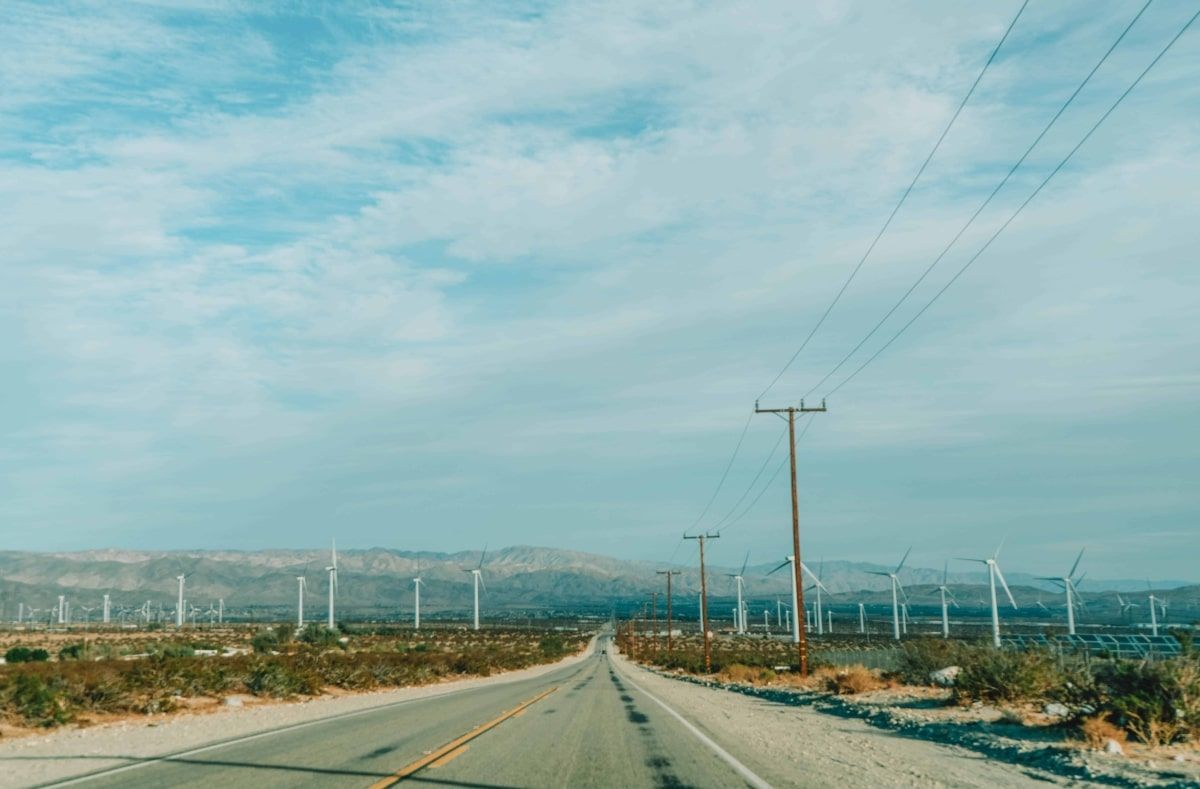
The shortest driving distance between San Francisco and LA is 383 miles, which takes about six to seven hours on I-5. However, traffic can extend a Los Angeles road trip considerably.
How to Drive from LA to San Francisco: Highway 101 or I-5?
The two most direct routes from LA to San Francisco are Highway 101 and I-5.
I-5 Route
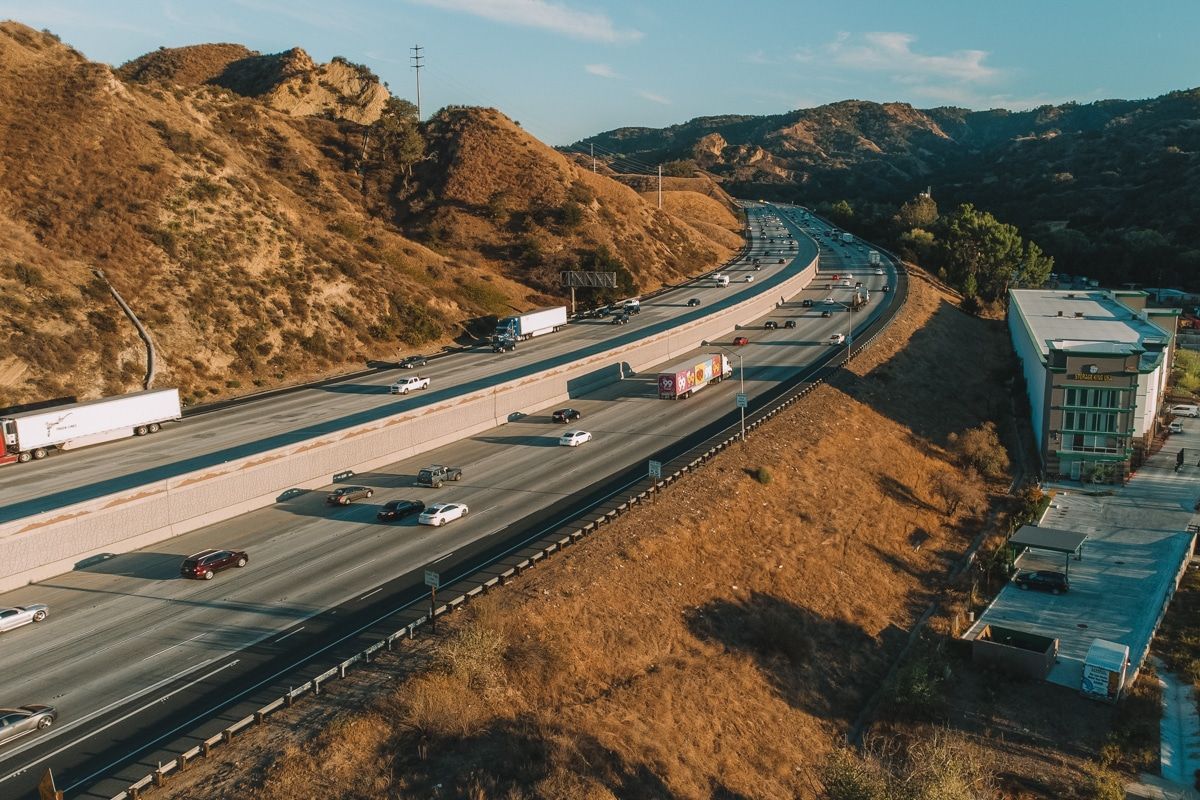
The quickest road trip route is I-5, cutting through California’s Central Valley. It takes about six to seven hours to drive the 383 miles from LA to San Francisco along I-5.
This route is the quickest way to get from point A to B, so it’s usually the one your navigation app will pick.
Along it, you’ll go through Santa Clarita, then climb up to Tejon Pass. The road then descends into the Central Valley, where it continues straight across miles of flat farmland.
There’s little to see and few worthwhile stops, so plan accordingly.
Looking for food options along the way? Harris Ranch Inn and Restaurant is a popular steakhouse about three hours north of LA in Coalinga.
Or, for a cheaper and faster stop, go to our cult-favorite California chain, In-n-Out Burger, in Kettleman City.
As for stretching your legs, stop at Vasquez Rocks Natural Park Area, between Santa Clarita and Palmdale, which features some nice rock formations in the high desert.
Pyramid Lake is another good stop. There’s a beach at Emigrant Landing, and boating is allowed on the lake, which you can reach from the Smokey Bear exit near Castaic.
Highway 101/Highway 1 Route

Highway 101, California’s longest route, starts in Washington state and ends in LA.
LA to San Francisco via Highway 101 and Highway 1 follows the Pacific Ocean coastline and is the more scenic of the two roads.
It takes nine to ten hours to drive the 430 miles of this route.
In complete contrast to I-5, there are tons of places to stop along this route, with many of the most interesting cities in California along this stretch.
You’ll also have the opportunity to take the Pacific Coast Highway (Highway 1), arguably the best drive in the world.
Sights include Santa Monica, Santa Barbara, Ventura, San Luis Obispo, San Simeon, Hearst Castle, Pinnacles National Park, San Jose, and Big Sur, where you can see Bixby Creek Bridge, Pfeiffer Beach, and Sand Dollar Beach.
I-5 vs Highway 101: Which is Better?
I’ve driven both routes and would only take I-5 again if I was in a big hurry.
There’s not much to see along the route, and worse, not as many places to stop. If traffic is awful and you need to stay the night, there aren’t as many options.
I always choose Highway 101 if I can help it.
Alternative Route: Highway 395

There’s one final route you can take that’s more roundabout and inland: Highway 395.
This route is the longest road trip at around 866 miles and 16 hours of driving time, but it’s equally spectacular as the coastal drive, especially in autumn with the fall foliage.
This inland route takes you across the Sierra Nevada past some of California’s most spectacular national parks, including Joshua Tree, Death Valley, and Yosemite.
Best Stops Along the Los Angeles to San Francisco Drive
Los Angeles

Why it’s worth visiting: The most famous California city boasts movie stars and mountain lions among its residents. Soak up the sunshine and the glamor in this unique, boisterous, and exciting place.
- Have fun at the theme parks, including Disneyland (a bit further south in Anaheim), Knott’s Berry Farm, and Universal Studios.
- Hike to the Hollywood Sign.
- Take a tour of famous homes.
- Snap a pic with your favorite stars on the Hollywood Walk of Fame.
- Take in the view from the Griffith Observatory.
- Visit the LACMA and Urban Light.
Read our guides to the best things to do in LA and where to stay in Los Angeles.
Santa Monica

Why it’s worth visiting: With its famous pier and beach packed with beautiful people, Santa Monica is the postcard-perfect Southern California town.
- Stroll down the iconic Santa Monica Pier and ride the Ferris wheel at Pacific Park.
- Swim at Santa Monica Beach and go on the swings.
- Ride bikes along The Strand.
- Enjoy a meal at one of the restaurants on pedestrianized Third Street Promenade.
Malibu

Why it’s worth visiting: This beachside city, surrounded by mountains and lush canyons, is a billionaire’s playground and surfer’s paradise.
- See the abandoned M*A*S*H set at Malibu Creek State Park.
- Take a surfing lesson at Zuma Beach.
- Book a table at Nobu or Geoffrey’s for a romantic dinner overlooking the ocean.
Read our guides to the best things to do in Malibu, the best Malibu hikes, and the best beaches in Malibu.
Ventura
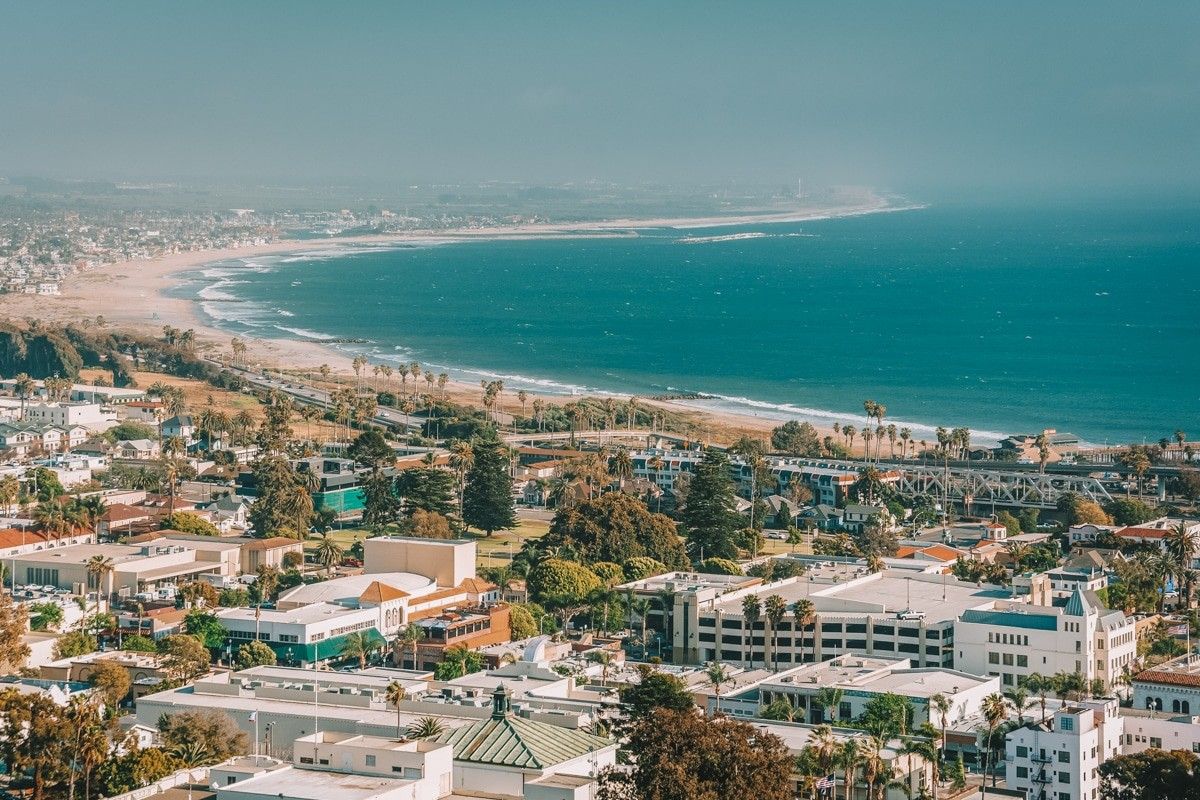
Why it’s worth visiting: Historic downtown Ventura’s independent boutiques make this beachside city perfect for souvenir shopping, while the bustling marina is the gateway to the stunning Channel Islands. It’s also one of the best places on the Central Coast for fresh fish tacos!
- Take a ferry to one or two of the stunning Channel Islands.
- Explore historic downtown Ventura.
- Go on a whale-watching cruise.
- Take a paddle boat out in the harbor.
Santa Barbara

Why it’s worth visiting: It’s one of the prettiest towns in Central California, with graceful Spanish architecture, beautiful beaches, and the serene Los Padres National Forest. From Ventura to here is also one of the prettiest California road trips.
- Relax on one of the white sand beaches.
- Go for a hike in Los Padres National Forest.
- Admire the flowers in Santa Barbara Botanic Garden.
- Check out the animals at the Santa Barbara Zoo.
- Walk along State Street in downtown Santa Barbara.
- Visit the Old Mission Santa Barbara.
Solvang

Why it’s worth visiting: Escape to Europe for the day in this quirky town, where you’ll find colorful boutiques, Danish bakeries, and a large windmill.
- Check out the Hans Christian Anderson Museum.
- Savor an authentic Danish pastry at one of the bakeries.
- Go wine tasting at one of the nearby vineyards in the Santa Ynez Valley.
Read our complete guide to the best things to do in Solvang.
Pismo Beach

Why it’s worth visiting: This charming Central Coast town is perfect for whale watching and a day at the beach.
- Take a dune buggy out into the Oceano sand dunes.
- Take a guided kayak tour along the Pismo Beach coast and try to spot some sea life.
- Watch the surfers and enjoy the laidback vibes at Pismo Beach Pier.
San Luis Obispo

Why it’s worth visiting: This foodie destination offers wine-tasting rooms, a farmers’ market, and top restaurants. Go a little further to spot adorable sea otters at nearby Morro Bay.
- Go on a walking tour that includes the famous Bubble Gum Alley.
- Pick out the freshest produce at the Saturday Farmer’s Market.
- Ride the historic trolley to one of the top restaurants downtown.
- Enjoy some wine tasting.
- See the iconic rock formation further north in nearby Morro Bay and admire the sea otters.
San Simeon

Why it’s worth visiting: Media magnate William Randolph Hearst thought San Simeon was so idyllic he built his legacy on the mist-shrouded hill: a castle fit for a newspaper king.
Aside from the historic home, this is where you can get up close to an extraordinary elephant seal colony.
- Stop for lunch in the cute coastal town of Cambria on the way in.
- Visit Hearst Castle and take the Grand Rooms Tour to learn about this unique place.
- Visit the elephant seal vista point at Point Piedras Blancas.
Julia Pfeiffer Burns State Park
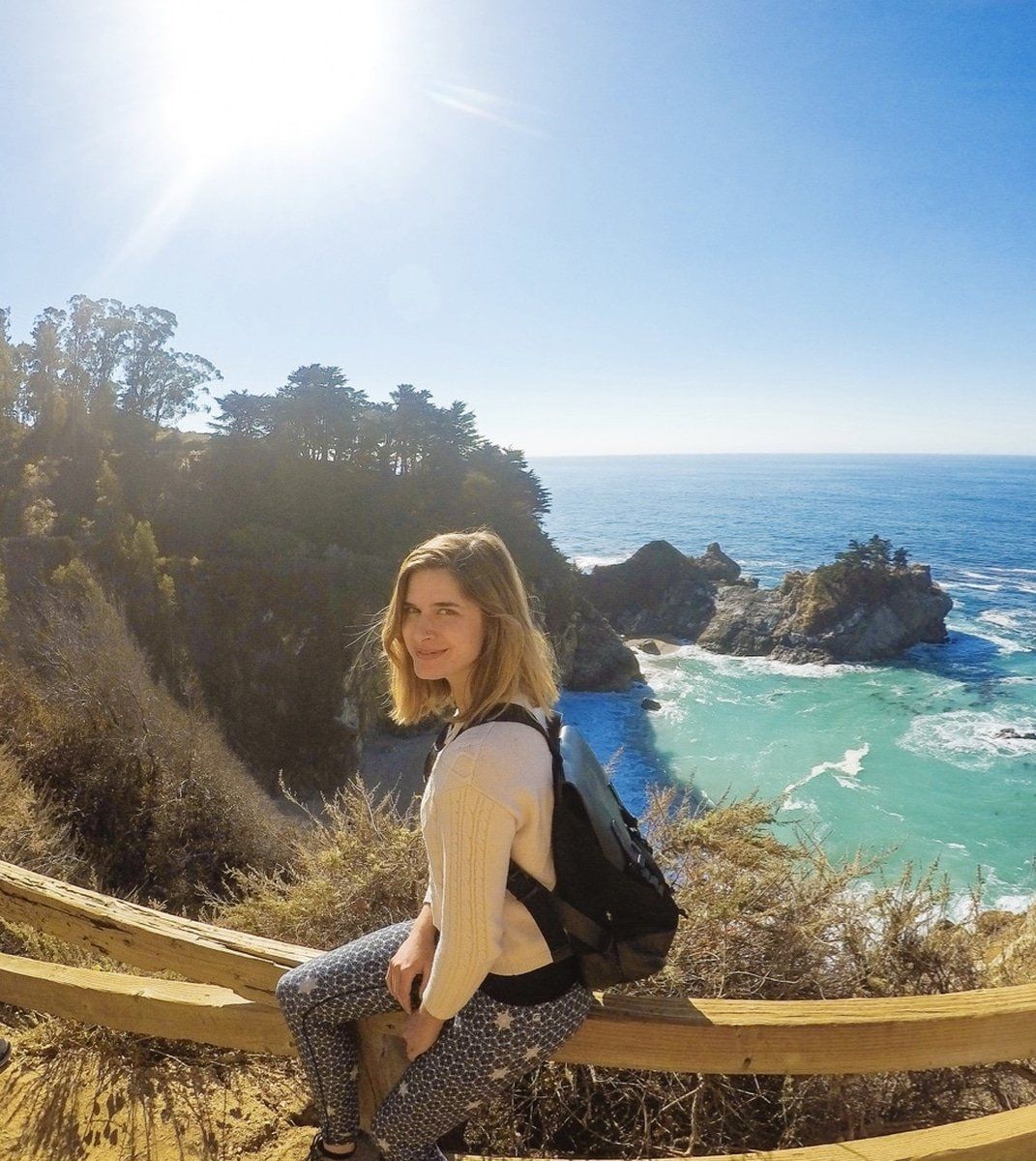
Why it’s worth visiting: See the rare tide fall (where a waterfall pours directly into the ocean) at McWay Falls.
- Hike to McWay Falls to see the waterfall.
- Look out for California condors, a once rare species now flourishing in Big Sur.
Pfeiffer Big Sur State Park

Why it’s worth visiting: The most scenic part of the Big Sur region boasts redwoods and a breathtaking coastline.
Pfeiffer State Park, in the heart of Big Sur, is close to cute bakeries, luxury resorts, and art galleries.
- Stay at the adults-only Ventana Big Sur and treat yourself to one of their massages and Japanese hot baths.
- Stop for a picture of the famous Bixby Bridge just north of the park.
- Experience the sun setting through a natural archway at nearby Pfeiffer Beach, which has purple sand.
Read our guides to the best hikes in Big Sur and Big Sur camping.
Carmel-by-the-Sea

Why it’s worth visiting: Don’t let the fairytale cottages fool you. From history to hikes at Point Lobos State Reserve, there’s much more than meets the eye in the laidback coastal town of Carmel.
- Hike the trails at California’s “crown jewel” of state parks, Point Lobos State Natural Reserve.
- Shop the art galleries and boutiques in downtown Carmel.
- See the historic Carmel Mission.
- Relax at Carmel Beach.
Read our guides to the best things to do in Carmel and the best restaurants in Carmel.
Monterey

Why it’s worth visiting: The Monterey Bay Aquarium gets almost two million annual visitors, but there’s plenty more to see in this fun seaside town.
Enjoy a seafood dinner at one of the many top-notch restaurants, kayak the bay, or visit Pebble Beach while you’re here.
- Spend a few hours at the aquarium.
- Enjoy a local seafood dinner at Old Fisherman’s Wharf.
- Do a road trip along the 17-Mile Drive.
- See the Monarch butterflies return to the Monterey Peninsula at Pacific Grove in the winter.
- Walk around the famous Cannery Row.
Read our guides to the best things to do in Monterey and the best restaurants in Monterey.
Santa Cruz
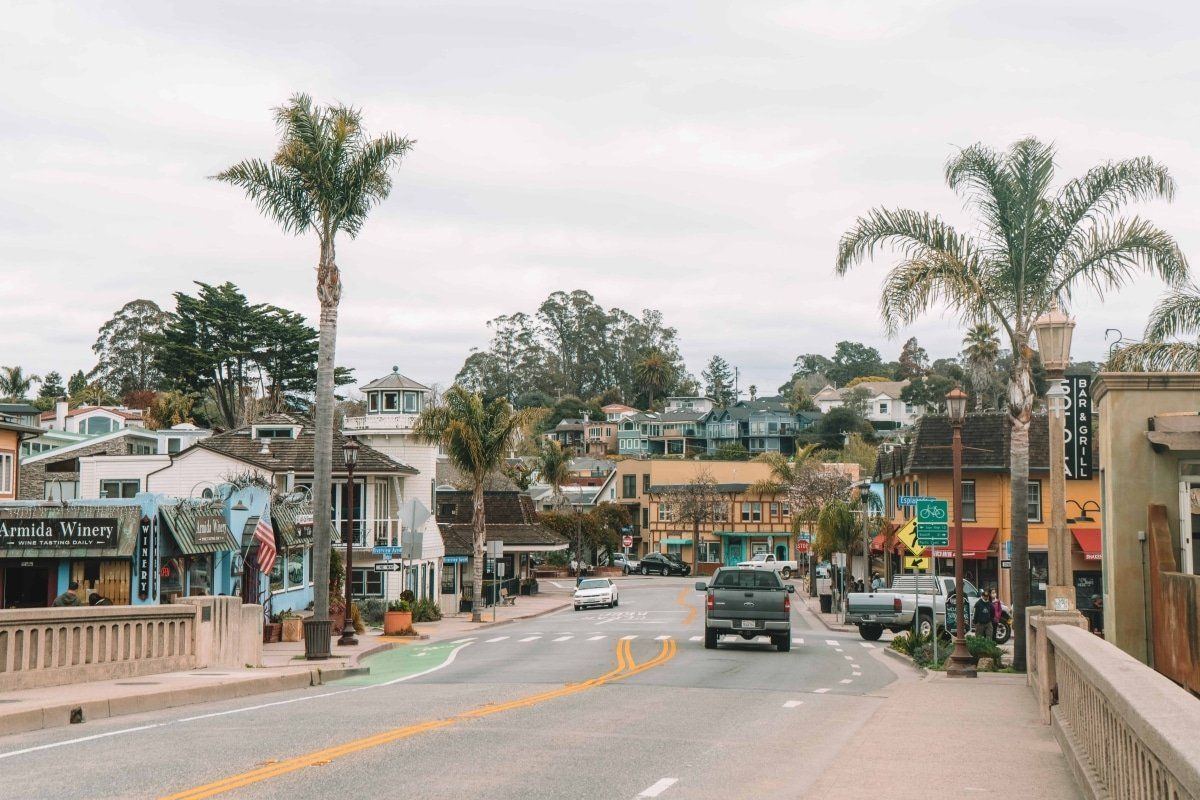
Why it’s worth visiting: Santa Cruz is an artistic haven, surfing mecca, and all-around fun town. Although the popular Santa Cruz Beach Boardwalk is best in the summer, the city is vibrant all year.
- Ride the rollercoasters at the Santa Cruz Boardwalk.
- Take a trip on the Roaring Camp steam train into the Santa Cruz Mountains at Henry Cowell State Park.
- Build sandcastles and explore tide pools at Natural Bridges State Beach.
- Walk along West Cliff Drive at sunset.
- Explore Pacific Avenue in downtown Santa Cruz.
Read our guides to the best things to do in Santa Cruz, the best Santa Cruz hikes, and the best beaches in Santa Cruz.
San Jose

Why it’s worth visiting: Silicon Valley’s self-styled capital has a thriving downtown with theaters staging the latest broadway shows and a museum showcasing cutting-edge science and cuisine from around the world.
Also, consider flying in and out of San Jose International Airport, which is smaller than San Francisco International Airport.
- Visit the quirky Winchester Mystery House.
- Peak into the future at The Tech Interactive, an all-ages science museum.
- Go for a hike in one of San Jose’s beautiful parks.
- Shop ‘til you drop at Santana Row.
Read our guides to the best things to do in San Jose and the best San Jose hikes.
Half Moon Bay

Why it’s worth visiting: Half Moon Bay is the windswept, romantic seaside town of your dreams.
- Relax with a beer at Half Moon Bay Brewing Company.
- Watch the surfers at Mavericks, where the annual surf contest happens.
- Browse the boutiques and bakeries of Main Street.
- Grab some delicious lobster rolls from Sam’s Chowder House.
San Francisco
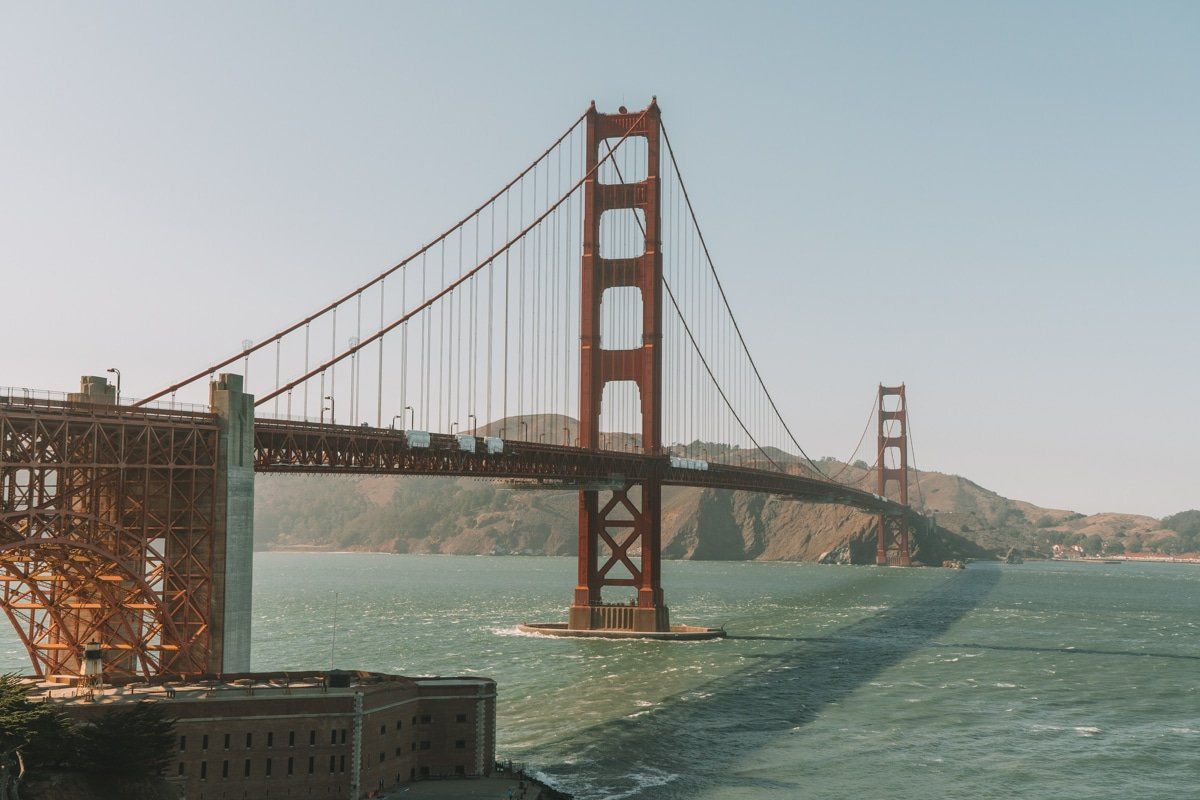
Why it’s worth visiting: Beyond the iconic Golden Gate Bridge, San Francisco is a city of activists, dreamers, artists, and oddballs, all colliding within seven square miles.
Admire the shiny tech towers downtown at union square, appreciate art in one of the many museums, and hold your nerve as you navigate the vertiginous hills.
- Ride a historic cable car to Fisherman’s Wharf and see the sea lions at Pier 39.
- Bring a picnic to Golden Gate Park and ride a swan boat on Stow Lake.
- Get the perfect picture of the Golden Gate Bridge, then walk or cycle across the landmark.
- Explore San Francisco’s bustling Chinatown.
- Shop at the funky thrift stores and boutiques along Haight Street.
- Enjoy San Francisco’s unique nightlife scene, including its many themed and rooftop bars.
- Hop on the ferry to Alcatraz Island, and tour the famed, now defunct, prison fortress.
- Eat your way around the city–whether that’s pizza, baked goods, or sushi.
Read our guides to the best things to do in San Francisco and the best hikes in San Francisco.
Where to Stay On Your Los Angeles to San Francisco Road Trip
Hotel Per La – Experience LA glamor at this cool Italian-inspired boutique hotel in downtown Los Angeles.
One-bedroom stone cottage in West LA – Stay in a cozy cottage close to the action in this guesthouse, which comes with its own pool and hot tub.
Angeles National Forest glamping – Relax in natural surroundings while close to the city in Paradise Springs, a glamping resort perfect for families and adventurous couples.
Santa Barbara
La Playa Inn – Rest up at this stylish and welcoming hotel just five minutes from the ocean. Breakfast and Wi-Fi come included in the rate.
Two-bedroom beach house – Open up the patio doors to experience the ocean breezes and indoor-outdoor living at this modern beach house that sits above Mesa Lane Beach.
El Capitan Santa Barbara – Stay in the Santa Ynez Mountains with all your creature comforts at El Capitan Canyon. Kids will love the heated swimming pool, while adults will enjoy the free Saturday night concerts in the summer.
San Luis Obispo
Madonna Inn – Forget the chain hotels and stay in this charming and iconic San Luis Obispo hotel where every room has different wild decor, and the pink champagne cake is to die for.
Two-bedroom 1920’s bungalow in downtown San Luis Obispo – Stay in the heart of downtown San Luis Obispo in your own cozy house.
Avila Beach glamping – Sleep by the ocean in your own RV or stay in one of the seaside cottages in Avila Beach at Flying Flags Avila Beach.
Carmel-by-the-Sea
Hyatt Carmel Highlands – Treat yourself to a luxurious stay at the beautiful Hyatt Carmel Highlands, which features a top-rated restaurant with sweeping views.
Three-bedroom cottage in downtown Carmel – Walk to downtown and the beach from this classic Carmel cottage, which includes a private courtyard with a fire pit, plus a full kitchen.
Treebones Resort – Get close to nature at Treebones Resort, where you can book your yurt for the night. While it’s not a kid-friendly resort, it’s perfect for couples.
Santa Cruz
Dream Inn Santa Cruz – This beachside Santa Cruz hotel has a swimming pool and hot tub, plus all guestrooms enjoy spectacular ocean views.
Two-bedroom home close to Santa Cruz Boardwalk in West Cliff – Stay like a local in one of West Cliff’s beautiful homes, close to the main attractions of Santa Cruz’s Beach Boardwalk and beaches.
Santa Cruz KOA – This camping resort is perfect for families, with a pool and playground to keep the kids entertained. Stay in your own RV or rent a retro Airstream trailer.
San Francisco
Hotel Caza Fisherman’s Wharf – Stay at Hotel Caza, which boasts spacious rooms, a swimming pool, an on-site restaurant, and free Wi-Fi. Free bikes are also available to explore the city.
Two-bed apartment in Russian Hill – Stay centrally in Russian Hill, a neighborhood famous for its beautiful homes and steep streets.
Angel Island camping – Bring your own camping gear and stay on Angel Island, a car-free island in the San Francisco Bay. Wake up to million-dollar views from your tent!
Los Angeles to San Francisco Road Trip Itineraries
2-Day Itinerary
A two-day itinerary gives you time to explore some of the Central Coast communities between Los Angeles and San Francisco on a classic California road trip.
Day One

Head north on Highway 101 from Los Angeles towards San Luis Obispo.
After one and a half to two hours, stop in Santa Barbara and explore this city’s waterfront, beautiful beaches, and botanic gardens.
Grab lunch in Santa Barbara, then head to Solvang for dessert from one of the Danish bakeries the town is famous for.
After admiring the windmill and stocking up on cookies, keep heading north along Highway 101 before stopping again at Pismo Beach.
Enjoy an afternoon hike along the beach before continuing to San Luis Obispo (or SLO, as locals call it) for dinner and checking into your hotel for the night.
Day Two
In the morning, spend some time in San Luis Obispo on a walking tour, or if it’s a Saturday, at the farmer’s market.
Hop in the car and follow Highway 101 north again as it heads away from the Pacific Ocean and cuts through California’s agricultural heartland.
It will take about two hours to reach Santa Cruz, where you’ll be back on the coast.
Hit up one of Santa Cruz’s authentic Mexican eateries for lunch, such as Taqueria Vallarta, Tortilla Flats, or El Palomar, then make your way over to the Santa Cruz Boardwalk for classic seaside fun.
If you have time, take Highway 1 up to San Francisco for a scenic route passing through Half Moon Bay and Pacifica.
If you’re short on time, drive through the mountains on Highway 17 before rejoining Highway 101. You’ll end your trip in San Francisco.
3-Day Itinerary

This three-day itinerary from LA to San Francisco gives you more time to explore the Pacific Coast Highway, known as Highway 1, on your Los Angeles to San Francisco road trip.
Day One
On day one, leave Los Angeles and follow Highway 101 to San Luis Obispo, stopping at Santa Barbara, Solvang, and Pismo Beach. You’ll stay in SLO this first night.
Day Two
Rise early and head north on the Pacific Coast Highway toward Carmel. This road is incredibly scenic but narrow and winding, so take it easy.
Stop at San Simeon for a few hours at Hearst Castle, a mansion built by famed architect Julia Morgan for the media magnate William Randolph Hearst.
At Point Piedras Blancas, pull into the car park at Point Piedras Blancas and check out the elephant seal colony.
These splendid creatures like to warm themselves on the sand before plunging back into the Pacific to feed.
Soon, you’ll drive into Big Sur, a beautiful stretch of coastline with several state parks to explore.
Make a quick stop at Julia Pfeiffer Burns State Park to see McWay Falls, Pfeiffer Big Sur State Park for a hike in the redwoods, and Point Lobos State Park to see the tide pools.
There are no big cities in this wild and difficult-to-reach region.
There are few roads, and winter storms often wash away whole sections of Highway 1, cutting off Big Sur communities entirely. Check to make sure the road is open before starting your trip.
You’ll stay in Carmel-by-the-Sea tonight.
Day Three
The drive from Monterey Bay to San Francisco is about two hours, so spend the morning exploring Carmel and Monterey.
Tour the fairy tale cottages of Carmel, shop the boutiques and art galleries, then take a mini-road trip up the 17 Mile Drive and see Pebble Beach, one of the best golf courses in the world.
In Monterey, visit the famous aquarium, then enjoy a fresh seafood lunch on Cannery Row or at Old Fisherman’s Wharf. Finally, head north up the peninsula to stay in San Francisco.
5-Day Itinerary

A five-day trip gives you more time to explore the coastal communities of Highway 1.
Day One
Drive north on Highway 101 from Los Angeles.
On your first day, stop in Santa Monica to see the famous Santa Monica Pier, Malibu for the beach, and Ventura for its vibrant harbor and downtown. Stay in Santa Barbara this first night.
Day Two
Spend the day driving between Santa Barbara and San Luis Obispo on Highway 101, visiting the town of Solvang, pausing for a Santa Ynez Valley wine tasting, and relaxing in Avila Beach.
Stop for lunch in Pismo Beach or Morro Bay, then end the day in San Luis Obispo.
Day Three
On day three, travel from San Luis Obispo to Carmel-by-the-Sea on Highway 1, which hugs the coast and offers some of the most scenic landscapes in California.
Make stops at San Simeon, Point Piedras Blancas, Julia Pfeiffer Burns State Park, Pfeiffer Big Sur State Park, and Point Lobos State Park before arriving in Carmel-by-the-Sea.
Download this Big Sur audio tour so you can learn about this extraordinary stretch of coast as you drive.
Stay in Carmel-by-the-Sea tonight.
Day Four
It’s a short drive between Carmel-by-the-Sea and Santa Cruz along Highway 1, so spend some time in Monterey exploring Pebble Beach, the 17 Mile Drive, Monterey Bay Aquarium, and Cannery Row today.
Stay the night in Santa Cruz.
Day Five
Take the iconic Pacific Coast Highway to travel between Santa Cruz and San Francisco to enjoy the picturesque beaches along the way.
There are several coastal cities to stop at on this stretch, including Pescadero, Half Moon Bay, and Pacifica.
End your trip in San Francisco.
7-Day Itinerary

You could easily extend the five-day Los Angeles to San Francisco road trip itinerary with an extra night in Santa Barbara and Carmel or a night in Ventura to visit the Channel Islands. Or, extend it on the frot end by starting your trip from San Diego.
Alternatively, drive the Sierra Nevada route to some of California’s most beautiful National Parks.
This LA to San Francisco drive is best in September or October when the crowds diminish and the heat is less intense before the snow.
Day One
Drive from Los Angeles to Joshua Tree National Park, which takes around two hours.
Either stay inside the park if you want to camp or outside if you prefer a vacation rental or hotel in the town of Joshua Tree.
Stay two nights in Joshua Tree National Park, where you can hike, climb, and stargaze in the desert.
Read our guides to glamping in Joshua Tree, Joshua Tree camping, the best Joshua Tree hikes, and the best things to do in Joshua Tree.
Day Three
Leave Joshua Tree National Park early and drive the four hours to Death Valley National Park.
Death Valley is huge, so I recommend staying within the park to reduce driving time. There are hotels as well as campgrounds in Stovepipe Wells and Furnace Creek.
Stay two nights in Death Valley and visit the unique landscape of canyons, salt flats, and incredible vistas.
Read our guides to the best things to do in Death Valley and Death Valley camping.
Day Five
From the lowest point in the US, hit Highway 395 and drive towards the highest-Mount Whitney.
From the west entrance of Death Valley National Park, it’s about two hours to Lone Pine, the gateway to Mount Whitney.
Take a detour to drive the scenic Mount Whitney Portal Road.
Continue driving for another hour along Highway 395 to Bishop, where you can visit the oldest living trees in the world at the Ancient Bristlecone Pine Forest.
These trees are thousands of years old and form beautiful, sculptural shapes.
The next stop is Mammoth Lakes, high in the Sierras at an elevation of 7,900 feet. This mountain town is an all-season resort, with skiing in the winter and hikes to beautiful Rainbow Falls in the summer.
From Mammoth Lakes, it’s a 30-minute drive along Highway 395 to Lee Vining, where you’ll spend the night.
Read our guides to the best things to do in Mammoth Lakes and the best hot springs in Mammoth Lakes.
Day Six
From Lee Vining, take Highway 120 to cross the Sierras through Yosemite National Park.
Depending on snow conditions, this road is only open in the summer, from around June to November.
Highway 120 (also known as Tioga Road or Tioga Pass) takes you past some of the most beautiful parts of Yosemite, including Tuolumne Meadows, Tenaya Lake, and Olmsted Point.
After exiting Yosemite’s western gate, stay in Mariposa.
Read our guides to the best things to do in Yosemite, the two-day Yosemite itinerary, the best views in Yosemite, where to stay in Yosemite, and Yosemite camping.
Day Seven
It’s about a three-hour drive from Yosemite to San Francisco through the upper part of California’s Central Valley. End your road trip in San Francisco.
Best Time to do a Los Angeles to San Francisco Road Trip

Highway 101 and I-5 are open year-round, so you can generally do those routes during any season.
Winter storms occasionally destroy parts of Highway 1, so always check conditions before you leave if you plan to drive the Pacific Coast Highway.
Although Highway 395 is open in the winter, the road through Yosemite National Park closes between November and May, so this is a summer-to-fall route only.
If you attempt this route in the winter, you need to continue north to Lake Tahoe and head back to the Bay Area by taking the Donner Pass (Interstate 80).
But summer is the best time to make this road trip as driving conditions are predictable. October is also beautiful in the Sierra Nevada region, with leaves in vibrant shades of red and gold.
Spring is also an incredible season in Big Sur because wildflowers burst into colorful life across the hills.
Tips for Planning a Road Trip from Los Angeles to San Francisco

- Due to winter storms, many drivers get stuck when roads suddenly close. Be prepared and check CalTrans for road conditions if you’re driving in the Sierras during fall, winter, or even spring.
- Consider renting a smaller car if you’re planning on driving up the California Coast on a Pacific Coast Highway trip since the roads are narrow and winding.
Renting a Car

To rent a car in California, you’ll need a valid driver’s license (an international license is acceptable, but be also prepared to show your passport), a credit card, and third-party liability insurance, which you can buy separately or at the counter.
In California, a spouse can drive without paying the fee as a second driver, provided they also have a license. Drivers must be at least 25.
A warning on insurance: there are two types of rental insurance: third-party liability and collision damage waiver.
You do not have to buy either from the rental company, BUT you must at least hold a third-party insurance policy to drive a vehicle in California legally.
Buying an insurance policy at the counter is expensive, adding up to $25 a day to the cost of the rental car.
I recommend buying your own policy separately or using your auto insurance if you own your own car in the US.
If you’re picking up a car in Los Angeles, the most convenient and cheapest place to rent is from the Los Angeles International Airport.
However, driving in LA is a headache–both in terms of LA drivers and the traffic.
If you’re spending some time in the city before starting your California road trip, it might be better to use public transit and ride shares to get around and pick up a rental once you’re leaving the city.
A standard mid-size rental car could cost between $60 and $100 daily, depending on where and when you rent.
Alternatively, you could rent a camper van and bring your accommodation with you— a great option if you’re also visiting national parks during your road trip.
FAQs About Getting from Los Angeles to San Francisco

Is it worth driving from LA to San Francisco? Is it pretty?
A road trip from Los Angeles to San Francisco is so much fun.
Stop at sandy beaches, grab lunch in pretty coastal towns, see unique wildlife like elephant seals and sea otters, and learn about the history of California at places like Hearst Castle.
Best of all, you can set your own schedule, spending as much time in each place as you like.
How long does it take to get from Los Angeles to San Francisco by plane? How about by train? How about a bus?
A flight from Los Angeles to San Francisco is about 1.5 hours, and it’s around 10 hours by train. A bus takes approximately eight to nine hours.
An LA to San Francisco tour is an alternative that allows you to see all the sights without driving anywhere.
How long does driving Highway 1 from LA to San Francisco take?
Without stopping, it would take about nine hours to do the LA to San Francisco drive on Highway 1.
How many days do you recommend driving from Los Angeles to San Francisco?
For the coastal route, I recommend at least three days.
Five days is best if you don’t want to feel too rushed or want to do the inland route over the Sierras (more if you’re spending time in the national parks).
You can do the Los Angeles to San Francisco drive in one day, but you won’t be able to do much except grab lunch along the way.
Plus, if you hit bad traffic, you’ll be glad you planned an overnight stop.
Is it better to do a San Francisco to Los Angeles Drive?
A San Francisco to Los Angeles road trip can be nice since you’ll be on the ocean side of the highway the whole way down.
ABOUT THE AUTHOR

Sarah McDonald
Sarah McDonald is a travel writer based in the Bay Area. She writes for the national parenting website Red Tricycle and on her family travel blog, Tiny Trailblazers. She loves exploring California’s outdoors and has a weakness for a national park gift shop.
Additional Expert Contributors: Suneel Jain and Elina Ansary.
Looking for more California travel inspiration? Read our related articles below!

Pin this image for future reference







